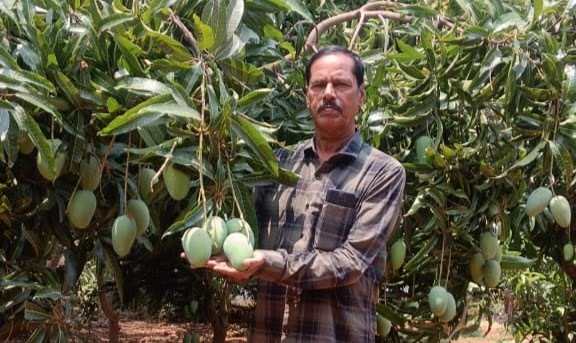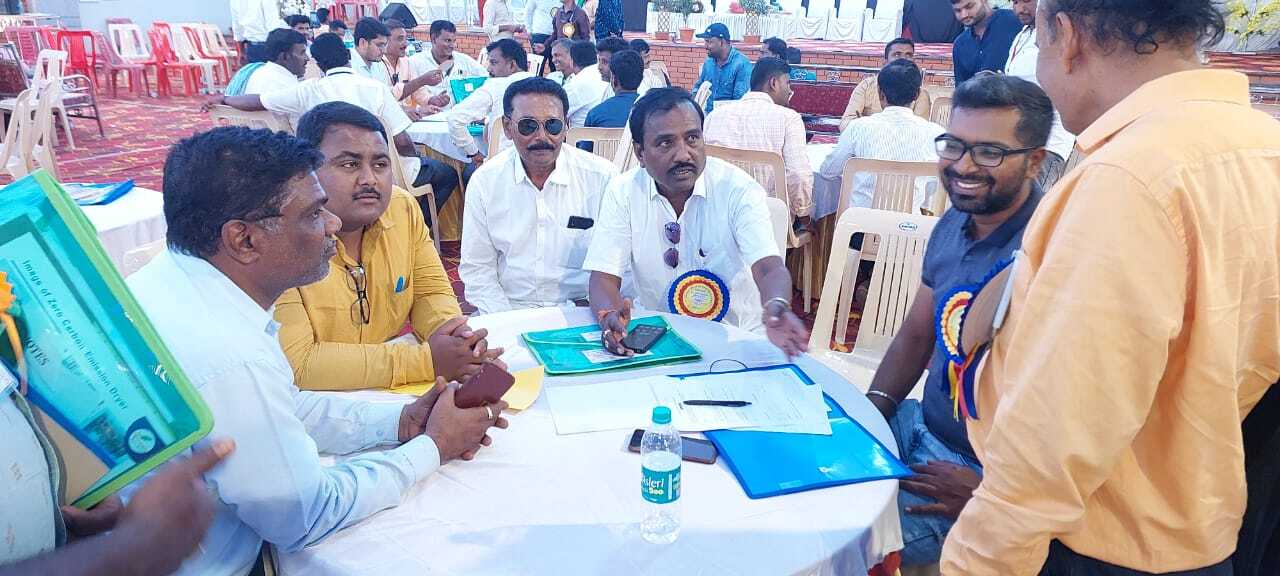From Rs 10 to Rs 150/kg: How Koppal’s Kesar Mangoes Became a Global Hit
Summers are a season when everyone eagerly awaits the arrival of mangoes and what if we say, one can get hold of their ripe, juicy and sweet mango in mid-April itself? All thanks to the Kesar variety of mango that is cultivated in Karnataka’s Koppal.
In Bengaluru, numerous households eagerly anticipate the annual arrival of Kesar mangoes from Koppal, typically delivered in mid-April following the harvest.
Among mango aficionados, the Kesar variety holds a special place, particularly those cultivated in the villages of Koppal. Padmakal T (48), a seasoned mango trader from Mandya shares, “Koppal’s Kesar mangoes attract traders from Hyderabad and Mumbai.”
 Renowned for their distinctive sweet and sour taste, the Kesar variety of mangoes has established a thriving presence in the villages of Koppal.
Renowned for their distinctive sweet and sour taste, the Kesar variety of mangoes has established a thriving presence in the villages of Koppal.
Renowned for their distinctive sweet and sour taste, the Kesar variety of mangoes has established a thriving presence in the villages of Koppal. The region’s unique soil and climatic conditions have profoundly shaped the flavour of these mangoes, setting them apart from those cultivated elsewhere.
This has led to the creation of a distinct brand, ‘Koppal Kesar,’ similar to “Devgad Hapus’— originating from the Sindhudurg district in Maharashtra — highlighting the region’s contribution to the mango’s unique identity.
Krishna Ukkunda, a horticulturist, has played a pivotal role in transforming the fortunes of Koppal’s mango growers. “Having posted to Koppal in 2016, I found that growers were cultivating both Kesar and Benishan mangoes. Despite the superior quality of Kesar mangoes, they were sold at a significantly lower price of Rs 10 per kg compared to Benishan, which fetched Rs 30 per kg,” says Ukkunda, now the Deputy Director of Horticulture in Koppal, who has worked to address this disparity and promote the Kesar variety.
 Mango exporters from Mumbai and Hyderabad interact with the farmers.
Mango exporters from Mumbai and Hyderabad interact with the farmers.
A year after Ukkanda arrived, he held a workshop for Koppal’s mango growers, who came from 15 villages. It was attended by 1,000-odd farmers, who were instructed on agronomic practices, organic methods of cultivation, how to combat pest infestation and drip irrigation.
For three long days, Mango exporters from Mumbai and Hyderabad stayed in the village, interacting with the farmers. The same year, in April and May, a 12-day-long ‘mango mela’ was organised to bring farmers and consumers together. Ever since then, it has been an annual feature, attracting hundreds of mango lovers to Koppal.
“In 2017, Koppal mango growers managed to sell fruits worth Rs 1 crore,” says Kannada journalist Ananda Theertha Pyati and a founding member of Sahaja Samrudha, an organic farmers’ association in Karnataka that promotes sustainable agriculture and agrobiodiversity. “That year, farmers priced the mangoes at Rs 80 per kg and 15 tonnes of mangoes were exported.”
Mango cultivation in dry climate
Ukkunda explains that Koppal’s climate plays a crucial role in the cultivation of the Kesar variety. The district experiences high summer temperatures, reaching up to 45°C, which accelerates the ripening process and enhances the sweetness and aroma of the fruit.
 Unlike Alphonso mangoes, which require high humidity for proper ripening, Kesar mangoes thrive in Koppal’s relatively dry conditions.
Unlike Alphonso mangoes, which require high humidity for proper ripening, Kesar mangoes thrive in Koppal’s relatively dry conditions.
Unlike Alphonso mangoes, which require high humidity for proper ripening, Kesar mangoes thrive in Koppal’s relatively dry conditions. These conditions prevent issues like sourness and sponginess during ripening, ensuring a consistent flavour.
Gujarat versus Karnataka’s Kesar: At Koppal, mangoes ripen earlier
Kesar mangoes in Koppal ripen earlier. While Gujarat’s harvest begins in June, Koppal’s mangoes are ready as early as mid-April, providing farmers with a competitive edge in the market.
“Its early arrival, that’s two months ahead of the Gujarat Kesar, has played in our favour,” says Ambaresh Tatti (32), owner of a 900-tree mango orchard spread on four and a half acres in Kaltavargera village.
 While Gujarat’s harvest begins in June, Koppal’s mangoes are ready as early as mid-April, providing farmers with a competitive edge in the market.
While Gujarat’s harvest begins in June, Koppal’s mangoes are ready as early as mid-April, providing farmers with a competitive edge in the market.
The district horticulture department has played a pivotal role by organising workshops, providing saplings, and aiding farmers in marketing their produce. Since 2017, Mango melas have been held in Koppal, but for 2019-2020, when the pandemic struck, with lesser sales, Ukkunda got 5,000 corrugated customised boxes made and shared contacts in Bangalore with the growers, who would be interested in Kesar Koppal.
Along with assistance provided by the Deputy Collector, ‘green passes’ were issued to traders to ferry mangoes to Aurangabad, Mumbai and Hyderabad.
Growth and international recognition
Over eight years, the area under Kesar mango cultivation in Koppal has expanded from 1,300 hectares to 5,000 hectares across 60 villages. With an expected yield of 60,000 tonnes this year, farmers now earn Rs 150–250 per kg, depending on quality.
This dramatic growth has been supported by the state government subsidies for drip irrigation systems and branding efforts under ‘Koppal Kesar,’ which has gained international recognition through exports to Sri Lanka, Dubai, Bahrain, Bangladesh, and Europe. Even during the pandemic (2019–2020), Ukkunda ensured uninterrupted sales to Indian cities.
Looking ahead
Farmers are hopeful about their prospects in kesar farming. Srinivas Jalihal, a 68-year-old farmer from Neologal village, cultivates mangoes on seven acres, including the Kesar, Mallika, and Benishan varieties.
He anticipates earning Rs 14 lakh this season by selling his produce at Rs 200 per kg. With continued support from horticulture authorities and increasing demand for Koppal Kesar, the district is poised for sustained growth in mango cultivation. Strategic branding, favourable climatic conditions, and farmers’ support have transformed Koppal into a hub for premium agricultural produce.
Edited by Vidya Gowri; All images courtesy Hiren Bose
News